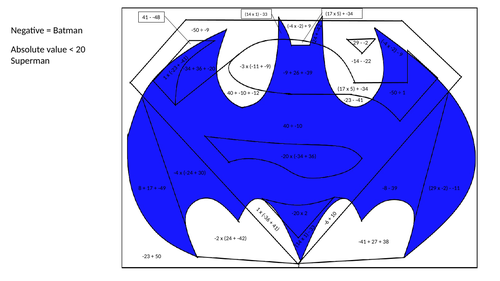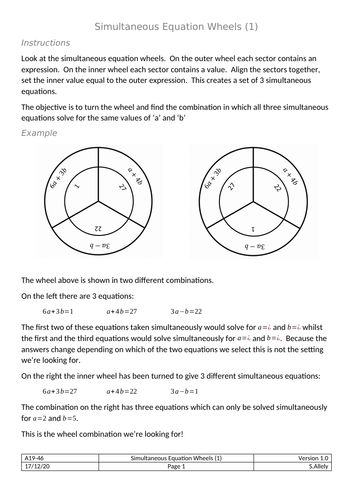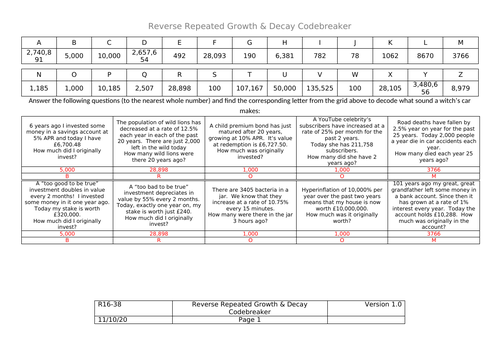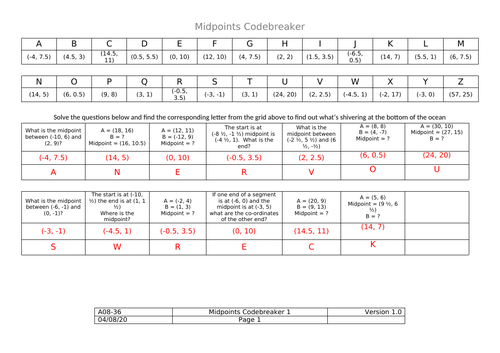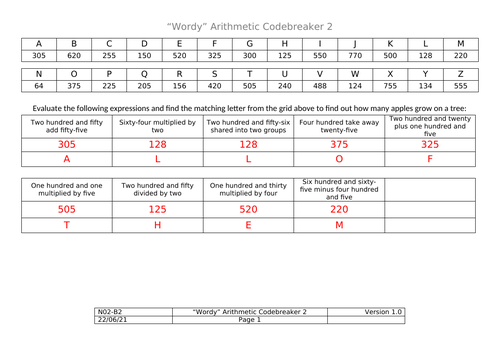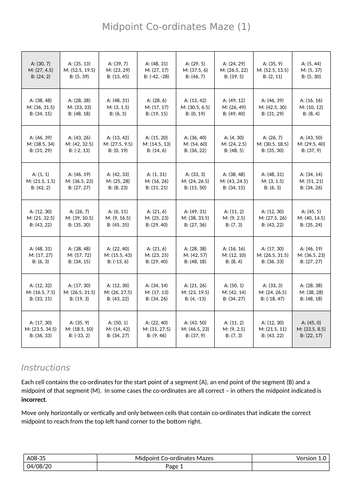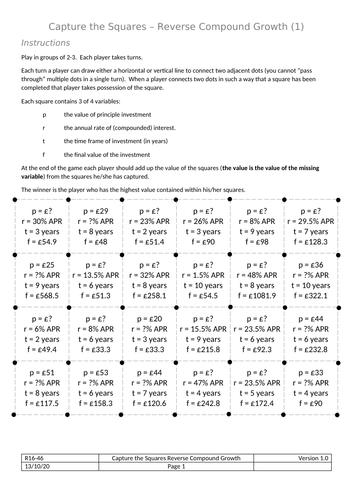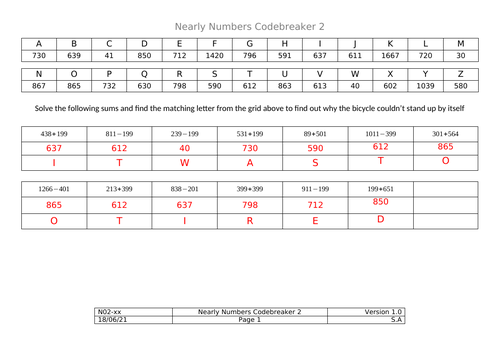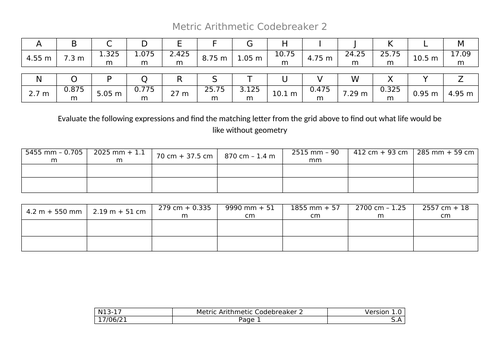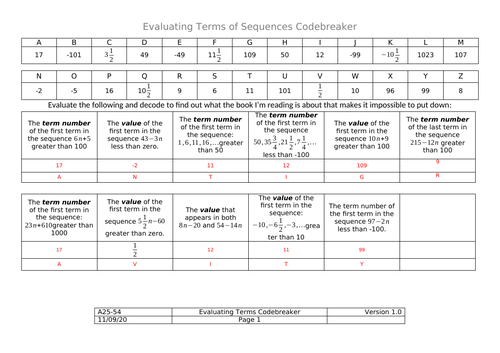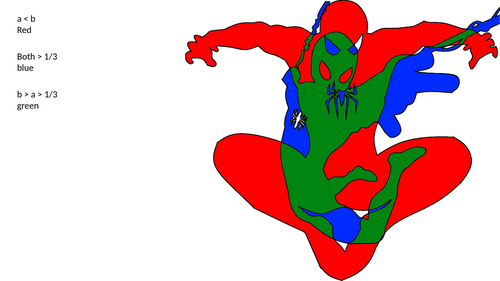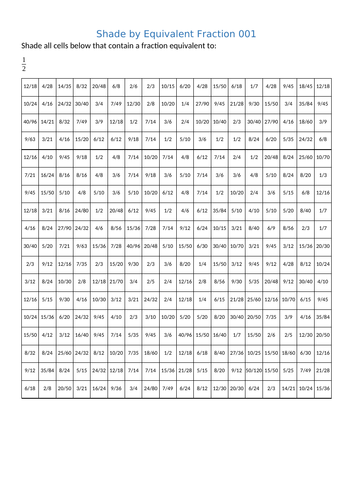
59Uploads
10k+Views
11k+Downloads
All resources

Codebreaker - Prime Factorisation
A codebreaker in the popular format. Students should convert numbers into prime factor index form to decode the answer to a bad joke (I no longer hate facial hair because it grew on me).
I had found plenty of other codebreakers on similar topics but not one specifically on prime factorisation so hopefully this is of use.

Shade by Directed Numbers
Shade (or don’t shade) the segments of the image based on whether the expression within evaluates to a positive or a negative number (directed number).
This resource also contains a second hidden hidden activity - shade the segments where the absolute value of the expression within is less than 20 to reveal a second (different) image).
Expressions are a mixture of addition, subtraction, multiplication and division.

Codebreaker - Ordering Directed Numbers
A codebreaker in the popular format based around ordering positive and negative numbers (directed numbers). Answering the questions and decoding provides the punchline to a bad joke (it was a freebie).
I’ve found plenty of other codebreakers online for directed numbers but none specifically on the foundational skill of ordering them so hopefully this is of use to someone out there.
There’s plenty of discerning understanding of place value (including decimals) with directed numbers and one question that involves fractions.

Wheels - Simultaneous Equations
The inner and outer wheels combine to form 3 different equations. Turn the inner wheel to change the combinations and generate 3 different simultaneous equations in 2 variables. Find the wheel setting that solve consistently for the same values of a & b.
I’ve made each resource twice - once designed to be just printed and once where the inner wheels can be cut out and pinned to the outer wheels using paper fasteners (solutions can be found in the “cutting version”)
My main motivation in making this resource was to present a rich problem solving activity for the topic in a visually novel format.

Codebreaker - Reverse Compound Growth & Decay
A codebreaker in the popular format. Students should reverse the compound interest (repeated percentage growth) or compound decay (repeated percentage decay) and use the answer to decode a joke.
As always, I only create codebreakers when I can’t find one that does exactly the same thing so hopefully someone else out there was looking for one that does what I’ve made this one for.

Plot Co-ordinates Superhero Picture
Plot the given co-ordinates to form an image of Ironman.
I’ve provided the same worksheet with 3 alternatives - one that forms the image entirely in the first quadrant, one that forms the image across the first and second quadrants and one that forms the image across all four quadrants.
This should allow for mild differentiation of the same activity.

Colour by Term in Sequence
Determine the position of a term in a sequence (given nth value). Colour each segment according to the missing position indicated by the expression.
Designed as a fluency activity for lower ability students or as a light revision activity for more able students.
The resource uses fractional coefficients (denominator of 2 only - always given as a decimal) but not fractional constants. As such it is more well suited to lower ability students.

Codebreaker - Midpoint coordinates
A codebreaker in the popular format. Students find the midpoint between two co-ordinates (or the end-point of a segment when given the midpoint) and decode to answer the question “what’s shivering at the bottom of the ocean?” (A Nervous Wreck)

Codebreakers - Four Operations (in words)
A couple of codebreakers (in the format that seems very popular on TES) that I made for use with low ability yr 7 students built around completing simple arithmetic but with numbers presented as words instead of as numerals.
There are two codebreakers here - the second one is more difficult than the first.

Midpoint coordinates Mazes
Move from square to square - only if the co-ordinates correctly indicate the midpoint of a line segment. Find the path through from the top left hand corner to the bottom right.
Incorrect midpoints are designed to highlight several popular misconceptions (e.g. calculating the average within the co-ordinates for A to get the ‘x’ co-ordinate for the midpoint and within the co-ordinates for B to get the ‘y’ co-ordinate for the midpoint, ignoring negative numbers when calculating the average, calculating the difference between the start and end co-ordinates but not adding this to the starting co-ordinates etc.)
The first maze only features co-ordinates in the first quadrant but subsequent mazes feature co-ordinates in all 4 quadrants.

Collecting Like Terms - Algebra-search
A “wordsearch” that operates by collecting like terms. A series of expressions are given and the students must find a line (horizontal, vertical or diagonal) that simplifies to that expression when like terms are collected.
The resource includes a series of progressively more difficult grids to figure out.

Capture the Squares Reverse Compound Interest
Players draw lines to complete squares. Whoever draws the last line captures the square. Each square contains 3 out of; the princpal value, the annual compound interest rate, the investment term and the final value. The “winner” of a square takes the value of the missing variable.
This activity is good for practicing repeated percentage change in a fun and engaging way.
The games become slightly more complex as you go through. Games 5 & 6 allow for annual percentage decay (depreciation).

Codebreakers - Nearly Numbers Addition
A couple of codebreakers in the popular format. Students should solve the basic arithmetic to decode the answer to a bad joke.
There are 2 codebreakers - both involve the addition/subtraction of “nearly numbers” (that should ideally be rounded to the nearest 10 or 100 first before attempting arithmetic). The first codebreaker is relatively simple, the second is a slight step up in difficulty.
Both codebreakers are designed to be used with low ability groups to facilitate an understanding of place value.

Codebreakers - Metric Length Addition & Subtraction
Codebreakers in the format popular on TES. These are focused on adding and subtracting lengths given in different units (e.g. mm + cm).
There are three codebreakers attached - each with a (bad) joke. They gradually become more difficult in various ways
Both codebreakers require students to convert units by multiplying/dividing by 10, 100 or 1000. The third is more challenging to decode (the units in the key for the first codebreaker are all in metres, this is not the case for the third).

Codebreaker - Evaluating Terms of Sequences
A codebreaker in the popular format. Students should evaluate the first/last term in a sequence to be greater than/less than a given amount etc. to decode the answer to a bad joke (I can’t put my book down because it’s about anti-gravity)
I had found plenty of other codebreakers on similar topics but not one specifically focused on evaluating terms so hopefully this is of use to people!

Colour by Fraction, Decimal & Percentage
Colour each segment of the picture according to the value of the fraction or decimal when converted into a percentage.
Suitable for lower ability groups or as light relaxing revision of the topic.

Colour by Reverse Percentage
Use reverse percentage to find the value of 100%. Colour each segment according to the value of 100% (once found).
Designed as a novel fluency task for low ability groups or as a light fluency revision activity for slightly more able students.
All expressions in this worksheet are percentages that are multiples of 5 to facilitate completion without a calculator. All answer values are integers. All percentages are less than 100%.
The image that becomes visible once coloured is a percentage symbol on a mostly white background.

Colour by Number of Factors
Colour each segment of the picture according to how many factors the number contained within the segment has.
Suitable for lower ability groups or as light relaxing revision of the topic.

Shade by Ordering/Comparing Fractions
Shade (or don’t shade) the segments of the image based on whether fraction ‘a’ is greater than fraction ‘b’.
This resource also contains a second hidden hidden activity - shade the segments where both fraction ‘a’ and fraction ‘b’ are greater than 1/3.
This is a task intended for lower ability students or for students who are just learning to compare fractions. In each pair the denominators are multiples of each other (there are no co-prime pairs of denominator in any segment) so to compare ‘a’ and ‘b’ only requires one of the fractions to be converted into an equivalent.

Shade by Equivalent Fractions Booklet
A 36 page booklet filled with equivalent fractions shading problems. Simply shade the cells that contain a fraction equivalent to the one listed at the top of the page to reveal an image.
There is a gradual increase in difficulty as the book progresses - all earlier pages require students to find equivalent fractions to simple unit fractions.


